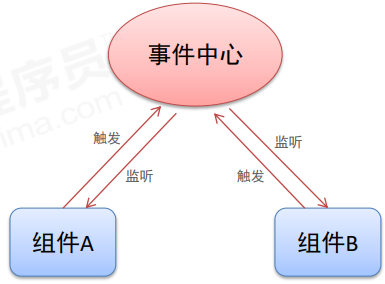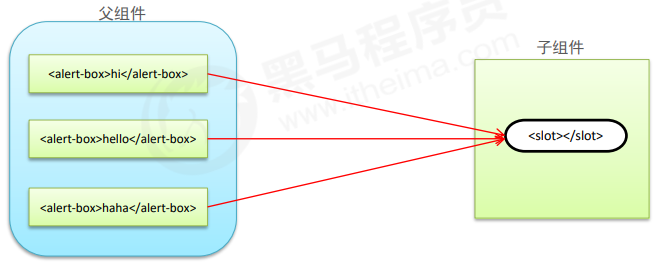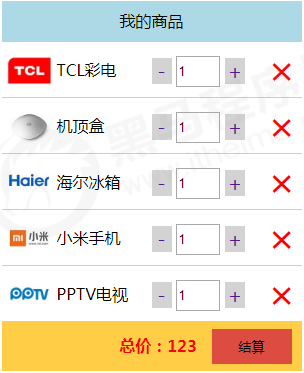L16-Vue-组件
目录
Vue - 组件
组件化开发思想
现实中的组件化思想体现
标准、分治、重用、组合
编程中的组件化思想体现

组件化规范: Web Components
- 我们希望尽可能多的重用代码
- 自定义组件的方式不太容易(html、css和js)
- 多次使用组件可能导致冲突
Web Components 通过创建封装好功能的定制元素解决上述问题
官网:https://developer.mozilla.org/zh-CN/docs/Web/Web_Components
Vue部分实现了上述规范
组件注册
全局注册
语法
Vue.component({string} name, {Function | Object} [definition])
用法:
注册或检索全局组件。注册还会使用给定的 name 参数自动设置组件的 name。
参数:
- {string} name 组件名称
- {Function | Object} [definition] 组件定义
- { props, data, methods, computed... }
返回值:
- 如果传入 definition 参数,返回应用实例(注册组件)。
- 如果不传入 definition 参数,返回组件定义(检索组件是否存在)。
示例
/* 注册一个名为my-component的组件 */
+ Vue.component('my-component', {
+ // ...
+ data: function(){
+ return {
+ msg: 'hello'
+ }
+ },
+ methods:{},
+ template: `
+ <div>
+ <h3>{{msg}}</h3>
+ <p>段落</p>
+ </div>
+ `
+ })
/* 检索注册的组件(始终返回构造函数) */
const MyComponent = Vue.component('my-component')
使用注册好的组件
/* 使用注册好的组件 */
<div id="app">
<my-component></my-component>
<my-component></my-component>
<my-component></my-component>
</div>
组件注册注意事项
-
data必须是一个函数
-
组件模板内容必须是单个跟元素
-
组件模板内容可以是模板字符串
-
组件命名方式
/* 短横线方式 */
Vue.component('my-component', { /* ... */ })
/* 驼峰方式 */
Vue.component('MyComponent', { /* ... */ })
局部注册
语法
var ComponentA = { /* ... */ }
var ComponentB = { /* ... */ }
var ComponentC = { /* ... */ }
new Vue({
el: '#app',
components: {
'component-a': ComponentA,
'component-b': ComponentB,
'component-c': ComponentC,
}
})
示例
// 注册 局部组件
new Vue({
el: '#app',
data: {
msg: 'hello'
},
+ components: {
+ 'com-son1': {
+ data: function(){
+ return {
+ msg: '子组件'
+ }
+ },
+ template: '<div>{{msg}}</div>'
+ }
+ }
});
// 使用 局部组件
<div id="app">
<com-son1></com-son1>
</div>
Vue调试工具用法
Vue调试工具:Devtools
安装
- 克隆仓库
- 安装依赖包
- 构建
- 打开Chrome扩展页面
- 选中开发者模式
- 加载已解压的扩展,选择shells/chrome
用法

组件间数据交互
父组件向子组件传值
-
组件内部通过props接收传递过来的值
Vue.component(‘menu-item', { props: ['title'], template: '<div>{{ title }}</div>' }) -
父组件通过属性将值传递给子组件
<menu-item title="来自父组件的数据"></menu-item> <menu-item :title="title"></menu-item> -
props属性名规则
- 在props中使用驼峰形式,模板中需要使用短横线的形式
- 字符串形式的模板中没有这个限制
Vue.component('menu-item', { // 在 JavaScript 中是驼峰式的 props: ['menuTitle'], template: '<div>{{ menuTitle }}</div>' }) <!-- 在html中是短横线方式的 --> <menu-item menu-title="nihao"></menu-item> -
props属性值类型
- 字符串 String
- 数值 Number
- 布尔值 Boolean
- 数组 Array
- 对象 Object
子组件向父组件传值
-
子组件通过自定义事件向父组件传递信息
<button v-on:click='$emit("enlarge-text") '>扩大字体</button> -
父组件监听子组件的事件
<menu-item v-on:enlarge-text='fontSize += 0.1'></menu-item> -
子组件通过自定义事件向父组件传递信息
<button v-on:click='$emit("enlarge-text", 0.1) '>扩大字体</button> -
父组件监听子组件的事件
<menu-item v-on:enlarge-text='fontSize += $event'></menu-item>
非父子组件间传值
-
单独的事件中心管理组件间的通信
var eventHub = new Vue() -
监听事件与销毁事件
eventHub.$on('add-todo', addTodo) eventHub.$off('add-todo') -
触发事件
eventHub.$emit(‘add-todo', id)

组件插槽
作用:父组件向子组件传递内容

基本用法
-
插槽位置
Vue.component('alert-box', { template: ` <div class="demo-alert-box"> <strong>Error!</strong> <slot></slot> </div> ` }) -
插槽内容
<alert-box>Something bad happened.</alert-box>
具名插槽
-
插槽定义
<div class="container"> <header> <slot name="header"></slot> </header> <main> <slot></slot> </main> <footer> <slot name="footer"></slot> </footer> </div> -
插槽内容
<base-layout> <h1 slot="header">标题内容</h1> <p>主要内容1</p> <p>主要内容2</p> <p slot="footer">底部内容</p> </base-layout>
作用域插槽
应用场景:父组件对子组件的内容进行加工处理
-
插槽定义
<ul> <li v-for= "item in list" v-bind:key= "item.id" > <slot v-bind:item="item">{{item.name}}</slot> </li> </ul> -
插槽内容
<fruit-list v-bind:list= "list"> <template slot-scope="slotProps"> <strong v-if="slotProps.item.current">{{ slotProps.item.text }}</strong> </template> </fruit-list>
基于组件的案例
案例:购物车
UI

案例:需求分析
按照组件化方式实现业务需求
根据业务功能进行组件化划分
- 标题组件(展示文本)
- 列表组件(列表展示、商品数量变更、商品删除)
- 结算组件(计算商品总额)
案例:实现步骤
- 实现整体布局和样式效果
- 划分独立的功能组件
- 组合所有的子组件形成整体结构
- 逐个实现各个组件功能
- 标题组件
- 列表组件
- 结算组件



【推荐】国内首个AI IDE,深度理解中文开发场景,立即下载体验Trae
【推荐】编程新体验,更懂你的AI,立即体验豆包MarsCode编程助手
【推荐】抖音旗下AI助手豆包,你的智能百科全书,全免费不限次数
【推荐】轻量又高性能的 SSH 工具 IShell:AI 加持,快人一步
· 无需6万激活码!GitHub神秘组织3小时极速复刻Manus,手把手教你使用OpenManus搭建本
· Manus爆火,是硬核还是营销?
· 终于写完轮子一部分:tcp代理 了,记录一下
· 别再用vector<bool>了!Google高级工程师:这可能是STL最大的设计失误
· 单元测试从入门到精通